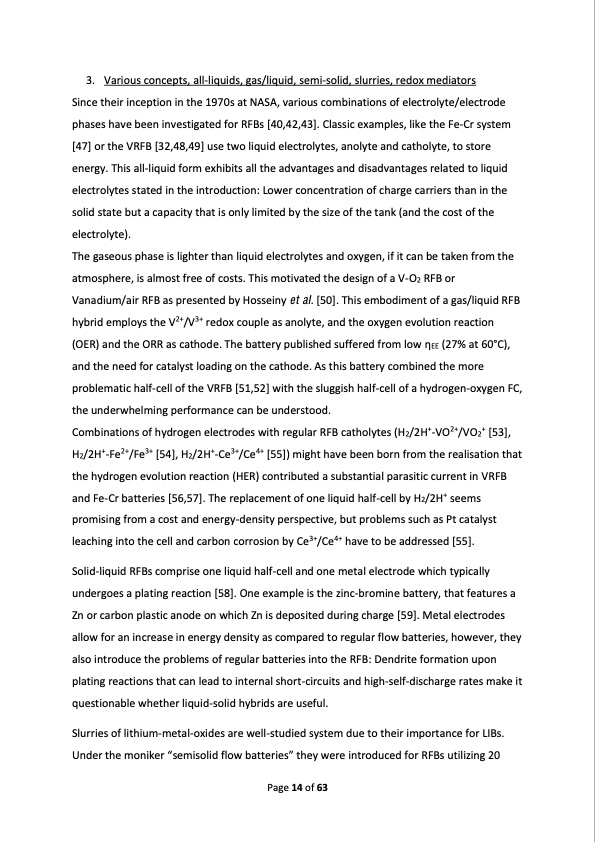
PDF Publication Title:
Text from PDF Page: 014
3. Various concepts, all-liquids, gas/liquid, semi-solid, slurries, redox mediators Since their inception in the 1970s at NASA, various combinations of electrolyte/electrode phases have been investigated for RFBs [40,42,43]. Classic examples, like the Fe-Cr system [47] or the VRFB [32,48,49] use two liquid electrolytes, anolyte and catholyte, to store energy. This all-liquid form exhibits all the advantages and disadvantages related to liquid electrolytes stated in the introduction: Lower concentration of charge carriers than in the solid state but a capacity that is only limited by the size of the tank (and the cost of the electrolyte). The gaseous phase is lighter than liquid electrolytes and oxygen, if it can be taken from the atmosphere, is almost free of costs. This motivated the design of a V-O2 RFB or Vanadium/air RFB as presented by Hosseiny et al. [50]. This embodiment of a gas/liquid RFB hybrid employs the V2+/V3+ redox couple as anolyte, and the oxygen evolution reaction (OER) and the ORR as cathode. The battery published suffered from low �EE (27% at 60°C), and the need for catalyst loading on the cathode. As this battery combined the more problematic half-cell of the VRFB [51,52] with the sluggish half-cell of a hydrogen-oxygen FC, the underwhelming performance can be understood. Combinations of hydrogen electrodes with regular RFB catholytes (H2/2H+-VO2+/VO2+ [53], H2/2H+-Fe2+/Fe3+ [54], H2/2H+-Ce3+/Ce4+ [55]) might have been born from the realisation that the hydrogen evolution reaction (HER) contributed a substantial parasitic current in VRFB and Fe-Cr batteries [56,57]. The replacement of one liquid half-cell by H2/2H+ seems promising from a cost and energy-density perspective, but problems such as Pt catalyst leaching into the cell and carbon corrosion by Ce3+/Ce4+ have to be addressed [55]. Solid-liquid RFBs comprise one liquid half-cell and one metal electrode which typically undergoes a plating reaction [58]. One example is the zinc-bromine battery, that features a Zn or carbon plastic anode on which Zn is deposited during charge [59]. Metal electrodes allow for an increase in energy density as compared to regular flow batteries, however, they also introduce the problems of regular batteries into the RFB: Dendrite formation upon plating reactions that can lead to internal short-circuits and high-self-discharge rates make it questionable whether liquid-solid hybrids are useful. Slurries of lithium-metal-oxides are well-studied system due to their importance for LIBs. Under the moniker �semisolid flow batteries� they were introduced for RFBs utilizing 20 Page 14 of 63PDF Image | Redox Flow Batteries Concepts Chemistries

PDF Search Title:
Redox Flow Batteries Concepts ChemistriesOriginal File Name Searched:
5870EAF5-2D70-44C8-A0A7-62D3A1462269.pdfDIY PDF Search: Google It | Yahoo | Bing
Salgenx Redox Flow Battery Technology: Salt water flow battery technology with low cost and great energy density that can be used for power storage and thermal storage. Let us de-risk your production using our license. Our aqueous flow battery is less cost than Tesla Megapack and available faster. Redox flow battery. No membrane needed like with Vanadium, or Bromine. Salgenx flow battery
| CONTACT TEL: 608-238-6001 Email: greg@salgenx.com | RSS | AMP |